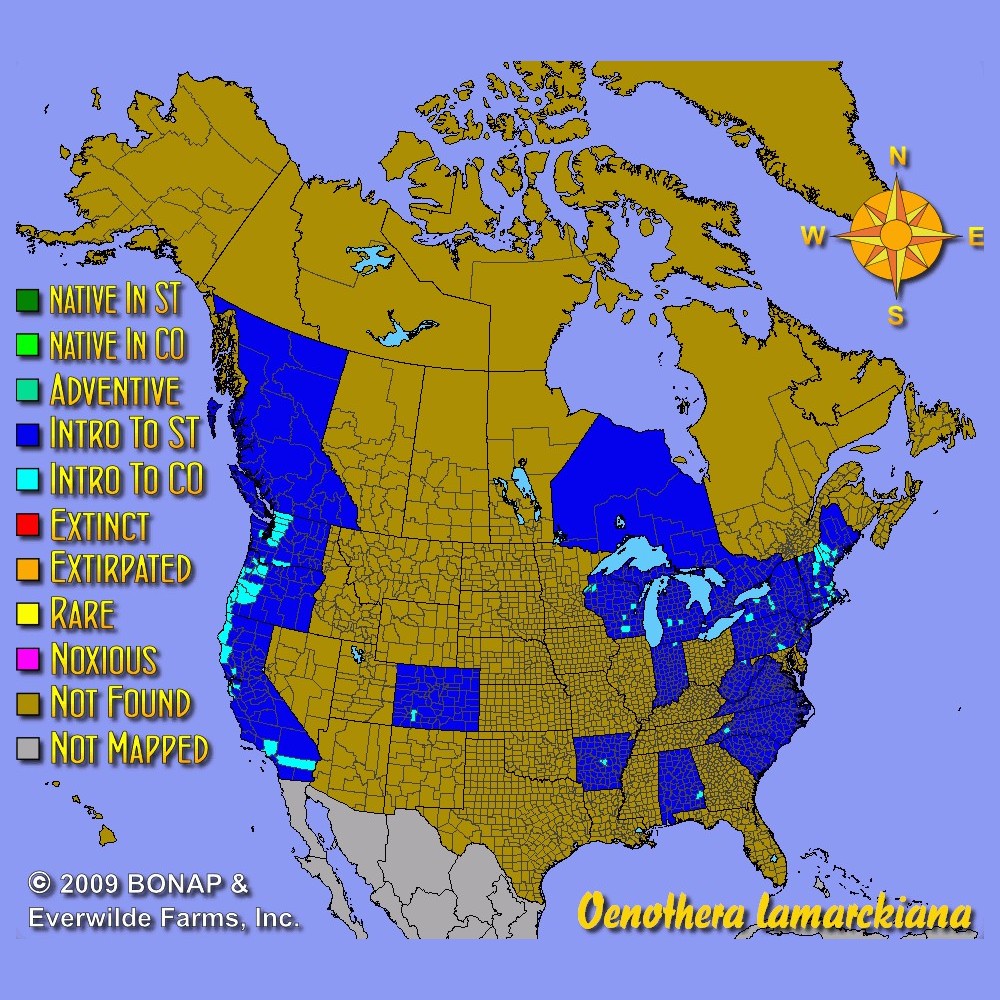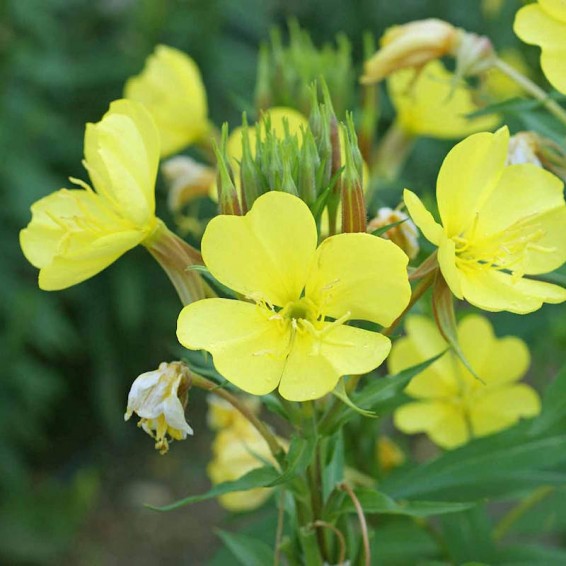Common Evening Primrose Seeds
- HOW TO GROW
- FAST FACTS
- REVIEWS
HOW TO GROW
Sowing: Direct sow in early spring, pressing lightly into the surface of the soil since the Oenothera Lamarckiana seed needs light to germinate. Keep the soil lightly moist until germination, which should occur within 10-30 days. When the seedlings can safely be handled, thin or transplant for wider spacing. For an early start, start the Oenothera Lamarckiana seed indoors 8-10 weeks before the last frost and transplant outdoors.
Growing: Water the seedlings until they become established. Mature plants can tolerate almost any type of soil, though they tend to wilt in extremely dry soil. This plant needs little care and grows easily; it can quickly spread and become invasive if not controlled, since it reseeds prolifically. To help prevent this, the plants can be cut back after blooming. This plant attracts birds and resists deer.
Harvesting: These short-lived blossoms do not make good cut flowers, and are best enjoyed in the wild.
Seed Saving: After flowering, slender ridged pods will develop; keep in mind that these pods provide food for small birds, and may need to be protected in order to preserve the seed. Eventually the pods will turn brown, split open, and drop their seed. Collect the pods as soon as they begin to turn brown, making sure the seed inside has ripened to a dark brown. After the pods have dried, remove the seed. Store the Oenothera Lamarckiana seed in a cool, dark place.
FAST FACTS
Common Names: Large-flower Evening Primrose, Redsepal Evening Primrose
Latin Name: Oenothera lamarckiana
Species Origin: Introduced US Wildflower
Type: Garden Flowers
Life Cycle: Biennial, Perennial
USDA Zones: 2, 3, 4, 5, 6, 7, 8, 9, 10, 11, 12
US Regions: California, Mountain, Arid/Desert, Plains/Texas, Midwest, Northern, Northeast, Southeast
Seeds per Ounce: 65,000
Stratification: No Stratification
Germination Ease: No Stratification
Sunlight: Full Sun
Height: 48 Inches
Color: Yellow
Bloom Season: Blooms Early Summer, Blooms Late Summer
Uses: Deer Resistant
A little more difficult to grow than I can handle
I waited until it was too hot to plant the seeds and then over watered them and then let them dry out for several weeks. It didn't work out with these seeds for me.
Arrived in great condition
Excellent packaging. All arrived in good condition. Looking forward to planting in Spring.
Quick turnaround!
The seeds speak for themselves.
Actually the seeds dont actually speak.......if you seeds speak to you consult a psychiatrist. I am a lifelong customer of everwilde and I have had the best luck(results would be a better word....its science not a lottery)with everwildes seeds. Their website is a plethora of information. The seed packaging is the best.
DESCRIPTION

HOW TO GROW
Sowing: Direct sow in early spring, pressing lightly into the surface of the soil since the Oenothera Lamarckiana seed needs light to germinate. Keep the soil lightly moist until germination, which should occur within 10-30 days. When the seedlings can safely be handled, thin or transplant for wider spacing. For an early start, start the Oenothera Lamarckiana seed indoors 8-10 weeks before the last frost and transplant outdoors.
Growing: Water the seedlings until they become established. Mature plants can tolerate almost any type of soil, though they tend to wilt in extremely dry soil. This plant needs little care and grows easily; it can quickly spread and become invasive if not controlled, since it reseeds prolifically. To help prevent this, the plants can be cut back after blooming. This plant attracts birds and resists deer.
Harvesting: These short-lived blossoms do not make good cut flowers, and are best enjoyed in the wild.
Seed Saving: After flowering, slender ridged pods will develop; keep in mind that these pods provide food for small birds, and may need to be protected in order to preserve the seed. Eventually the pods will turn brown, split open, and drop their seed. Collect the pods as soon as they begin to turn brown, making sure the seed inside has ripened to a dark brown. After the pods have dried, remove the seed. Store the Oenothera Lamarckiana seed in a cool, dark place.
FAST FACTS
Common Names: Large-flower Evening Primrose, Redsepal Evening Primrose
Latin Name: Oenothera lamarckiana
Species Origin: Introduced US Wildflower
Type: Garden Flowers
Life Cycle: Biennial, Perennial
USDA Zones: 2, 3, 4, 5, 6, 7, 8, 9, 10, 11, 12
US Regions: California, Mountain, Arid/Desert, Plains/Texas, Midwest, Northern, Northeast, Southeast
Seeds per Ounce: 65,000
Stratification: No Stratification
Germination Ease: No Stratification
Sunlight: Full Sun
Height: 48 Inches
Color: Yellow
Bloom Season: Blooms Early Summer, Blooms Late Summer
Uses: Deer Resistant
Reviews
Review
A little more difficult to grow than I can handle
I waited until it was too hot to plant the seeds and then over watered them and then let them dry out for several weeks. It didn't work out with these seeds for me.
Review
Arrived in great condition
Excellent packaging. All arrived in good condition. Looking forward to planting in Spring.
Review
Quick turnaround!
Review
The seeds speak for themselves.
Actually the seeds dont actually speak.......if you seeds speak to you consult a psychiatrist. I am a lifelong customer of everwilde and I have had the best luck(results would be a better word....its science not a lottery)with everwildes seeds. Their website is a plethora of information. The seed packaging is the best.





